
The Accipitridae is one of the three families within the order Accipitriformes, and is a family of small to large birds of prey with strongly hooked bills and variable morphology based on diet. They feed on a range of prey items from insects to medium-sized mammals, with a number feeding on carrion and a few feeding on fruit. The Accipitridae have a cosmopolitan distribution, being found on all the world's continents and a number of oceanic island groups. Some species are migratory. The family contains 255 species which are divided into 70 genera.
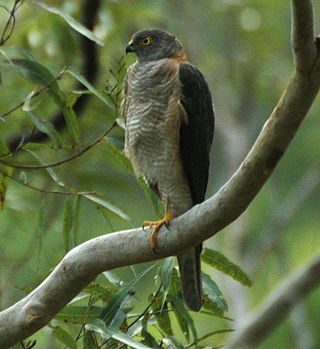
Accipiter is a genus of birds of prey in the family Accipitridae. With 49 recognized species it is the most diverse genus in its family. Most species are called goshawks or sparrowhawks, although with the exception of the American goshawk almost all New World species are simply known as "hawks". They can be anatomically distinguished from their relatives by the lack of a procoracoid foramen. Two small and aberrant species usually placed here do possess a large procoracoid foramen and are also distinct as regards DNA sequence. They may warrant separation in the old genus Hieraspiza.

Circaetinae is a bird of prey subfamily which consists of a group of medium to large broad-winged species. The group is sometimes treated as tribe Circaetini. These birds mainly specialise in feeding on snakes and other reptiles, which is the reason most are referred to as "snake-eagles" or "serpent-eagles". The exceptions are the bateleur, a more generalised hunter, and the Philippine eagle, which preys on mammals and birds.

The Accipitrinae are the subfamily of the Accipitridae often known as the "true" hawks, including all members of Accipiter and the closely related genera Erythrotriorchis, and Megatriorchis. The large and widespread genus Accipiter includes goshawks, sparrowhawks, the sharp-shinned hawk and others. They are primarily woodland birds that hunt by sudden dashes from a concealed perch, with long tails, broad wings and high visual acuity facilitating this lifestyle. In light of recent genetic research, the kites of the traditional subfamily Milvinae may also belong to this group.
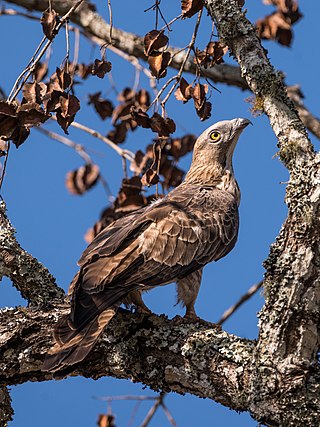
The crested honey buzzard is a bird of prey in the family Accipitridae, which also includes many other diurnal raptors such as kites, eagles, and harriers. Pernis ptilorhynchus has six subspecies. As a medium-sized raptor, their size ranges between 57–60 cm (22–24 in). They are also known as the Oriental, Asiatic, or Eastern honey buzzard. The name is derived from its diet, which consists mainly of the larvae of bees and wasps extracted from honey combs.

The shikra is a small bird of prey in the family Accipitridae found widely distributed in Asia and Africa where it is also called the little banded goshawk. The African forms may represent a separate species but have usually been considered as subspecies of the shikra. The shikra is very similar in appearance to other falcons species including the Chinese goshawk and Eurasian sparrowhawk. They have a sharp two note call and have the typical flap and glide flight. Their calls are imitated by drongos and the common hawk-cuckoo resembles it in plumage.

The besra, also called the besra sparrowhawk, is a bird of prey in the family Accipitridae.

The lizard buzzard, or lizard hawk, is a bird of prey in the family Accipitridae. It is native to Sub-Saharan Africa. Despite its name, it may be more closely related to the Accipiter hawks than the Buteo buzzards.

The changeable hawk-eagle(Nisaetus cirrhatus) or crested hawk-eagle is a large bird of prey species of the family Accipitridae. More informal or antiquated English common names include the marsh hawk-eagle or Indian crested hawk-eagle. It is a member of the subfamily Aquilinae, with signature feathers, absent in tropical raptors from outside this subfamily, covering the tarsus. It was formerly placed in the genus Spizaetus, but studies pointed to the group being paraphyletic resulting in the Old World members being placed in Nisaetus and separated from the New World species. It is a typical “hawk-eagle” in that it is an agile forest-dwelling predator and like many such eagles readily varies its prey selection between birds, mammals or reptiles as well as other vertebrates. Among the members of its genus, the changeable hawk-eagle stands out as the most widely distributed, adaptable and abundant species. Individuals show a wide range of variation in plumage from pale to dark, varying with moult and age giving rise to the name "changeable".
The Central Highlands of India are a biogeographic region in India formed by the disjunct ranges of the Satpura and Vindhya Hills. It is given the term 6A within the Deccan zone in the Rodgers and Panwar (1988) classification. The zone adjoins 6D, the Central Plateau and 4B, the Gujarat Rajputana and extends across the states of Maharashtra, Madhya Pradesh and Chhattisgarh. The total area is approximately 250,000 km2 and there are 27 Protected Areas covering 4.9% of the area. There are also six Project Tiger Reserves in the region.

Spizaetus is the typical hawk-eagle birds of prey genus found in the tropics of the Americas. It was however used to indicate a group of tropical eagles that included species occurring in southern and southeastern Asia and one representative of this genus in the rainforests of West Africa. The Old World species have been separated into the genus Nisaetus. Several species have a prominent head crest. These are medium to large-sized raptors, most being between 55 and 75 cm long, and tend to be long-tailed and slender.

The brown goshawk is a medium-sized bird of prey in the family Accipitridae found in Australia and surrounding islands.

The tiny hawk is a small diurnal bird of prey found in or near forests, primarily humid, throughout much of the Neotropics. It is primarily a bird-eater, and is known to prey on hummingbirds.

The semicollared hawk is a rare bird of prey species in the family Accipitridae. It is found in Colombia, Ecuador, Peru, and Venezuela. Its natural habitat is subtropical or tropical moist montane forests. It is potentially being affected by habitat loss.
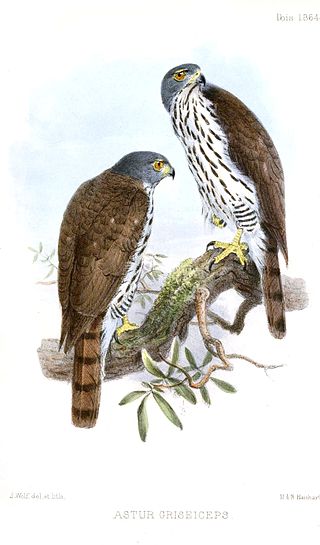
The Sulawesi goshawk is a species of bird of prey in the family Accipitridae. It is endemic to Sulawesi, Indonesia. Its natural habitats are subtropical or tropical moist lowland forest and subtropical or tropical moist montane forest.
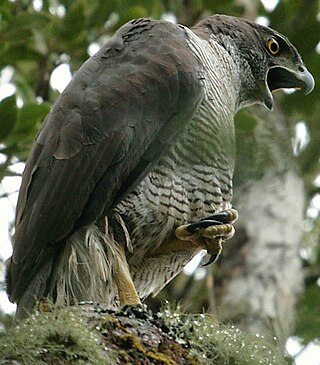
Henst's goshawk is a species of bird of prey in the family Accipitridae. It is a large, diurnal bird endemic to the island of Madagascar. It is an obligate forest species that occurs at very low densities on the island and is rarely seen. It can only occupy the primary and secondary forests found within the island. Its natural habitats are subtropical or tropical dry forest, subtropical or tropical moist lowland forest, subtropical or tropical moist montane forest, and plantations.
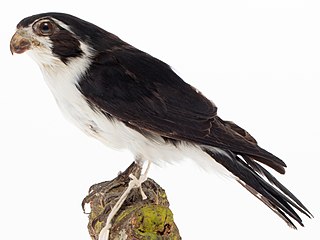
The pied falconet, is a species of bird of prey in the family Falconidae. It is found in Bangladesh, Bhutan, China, Hong Kong, India, Laos, and Vietnam. Its natural habitat is temperate forests.

Legge's hawk-eagle is a bird of prey. Like all eagles, it is in the family Accipitridae. It breeds in the Indian subcontinent, from southern India to Sri Lanka. Its specific name kelaarti honors the physician-zoologist E.F. Kelaart.
Goshawk may refer to several species of birds of prey, mainly in the genus Accipiter:

Microspizias is a genus of bird of prey in the family Accipitridae. It contains the following species:






















